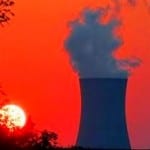Nuclear proponents argue that humans can store radioactive waste, but not solar energy. Tesla’s Elon Musk just proved them wrong.
One of the biggest furphies propagated by proponents of nuclear energy – that renewable energy cannot be cheaply stored – has been blown away by the battery storage pricing announcement of Tesla founder and chairman Elon Musk.
The focus of Tesla Energy’s battery storage announcement was on household solar storage. But it is possibly in the utility scale storage market that the impact will be most profound.
The Tesla PowerPack, a 100kWh battery storage array unveiled by Musk that can be readily scaled, will be offered at a capital cost of around $US250/kWh. For delivered energy, that equates to an extra 2c/kWh on the cost of renewable energy sources.
Musk said it could push fossil fuels out of the market. The conservative business magazine Forbes on the weekend said it could also be the “final in the coffin of nuclear.”
It quoted a debate between noted nuclear critic Arnie Gundersen and Jordi Roglans-Ribas, the director of the Nuclear Engineering Division of Argonne National Laboratory.
Roglans-Ribas, Forbes reported, had just finished delivering the normal nuclear argument that renewables could not replace fossil fuels because of the variability of solar and wind.
Gundersen called that claim a “marketing ploy.”
“We all know that the wind doesn’t blow consistently and the sun doesn’t shine every day, but the nuclear industry would have you believe that humankind is smart enough to develop techniques to store nuclear waste for a quarter of a million years, but at the same time human kind is so dumb we can’t figure out a way to store solar electricity overnight. To me that doen’t make sense.”
Gundersen points out that solar can now be delivered for around 6-7 US cents, and wind for less than 4 US cents/ per kilowatt hour. Musk’s utility scale storage adds 2 USc/kWh to that price, still much lower than what nuclear can deliver.
Musk is not the only battery storage developer to point out that utility scale storagte can provide all the “balance”, as well as the frequency, needed for grids, and previously provided by coal and nuclear. German company Younicos is arguing the same, as we reported in this article, “The battery storage system that could close down coal power”
Nuclear proponents continue to argue that nuclear is cheap, but the people within the industry know better.
Exelon, which operates 22 nuclear plants in the US, the most of any US utility, added its voice to that assessment last week. Not only are renewables half the price of new nuclear power, they are competing with already built nuclear power stations.
John Rowe, the newly retired CEO of Exelon, said nuclear power is no longer an economically viable source of new energy in the United States, and he said it won’t become economically viable for the forseeable future.
“Let me state unequivocably that I’ve never met a nuclear plant I didn’t like,” he told the University of Chicago‘s Harris School of Public Policy. “Having said that, let me also state unequivocably that new ones don’t make any sense right now.”
Even existing ones don’t make much sense. Exelon is threatening to close five nuclear power plants early because they are no longer profitable.
He’s not alone in thinking that new plants are too difficult. The Bulgarian government recently pulled out of a contract with Westinghouse, arguing that it was too expensive. The Russian government owned Rosenergoatom has pulled development of its next generation nuclear plants, saying it’s not convinced that economics don’t add up.
France’s nuclear flaghsips are facing technical problems and its major developer is virtually bankrupt. No government wants to take the risk of underwriting the first nuclear plant in the UK, despite a guaranteed tariff that starts at around $180/MWh in 2023 and finishes at nearly $500/MWh 35 years later.
“The operative word in this discussion tonight is now,” Gundersen said. “What are we going to do now to reduce the amount of carbon dioxide going into the atmosphere?”
“Solar, wind and storage can be implemented immediately. We know how to insulate a building. We know how to put double and triple-pane windows in them. We know how to build windmills and put solar cells up. These are immediate things. We don’t have to invest $50 trillion and wait 15 years for that to come to fruition.
“Producing our way out of the problem with renewables is half the solution. Conserving our way out is the other half.”







